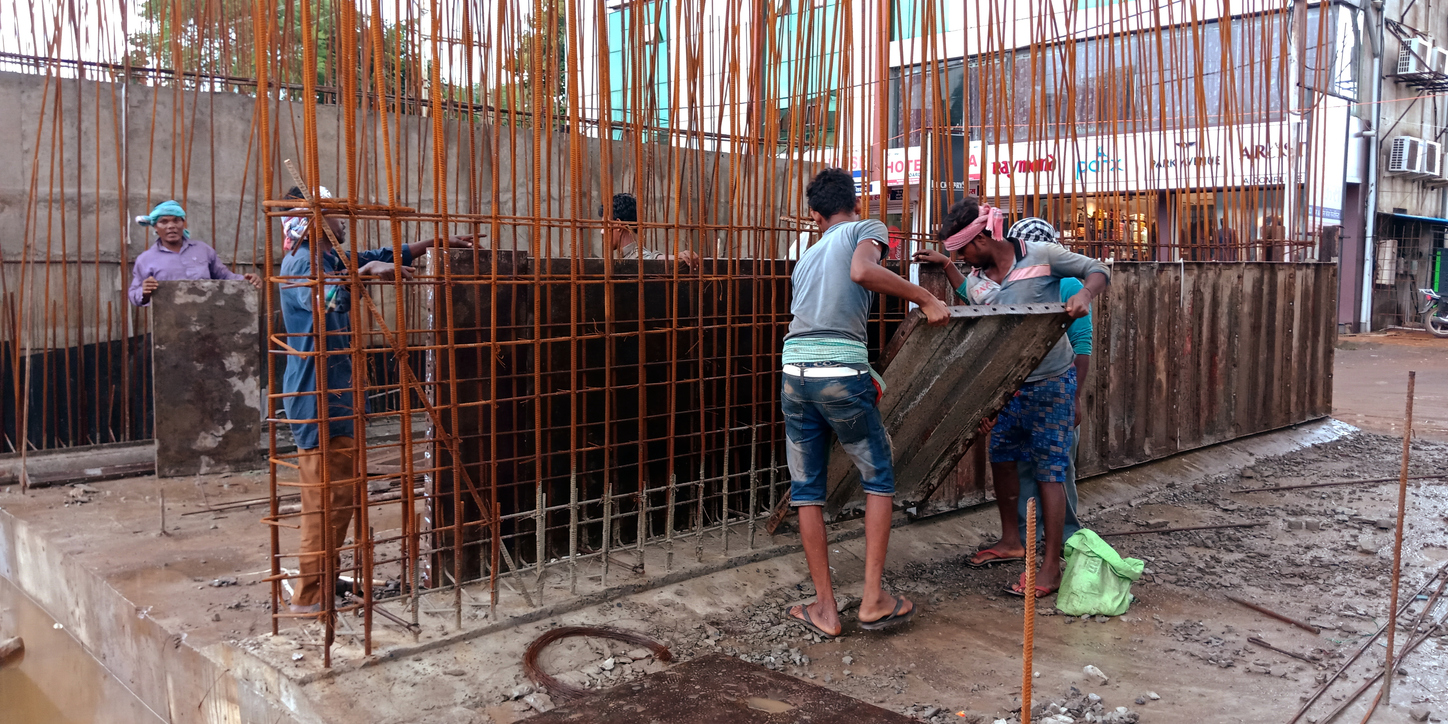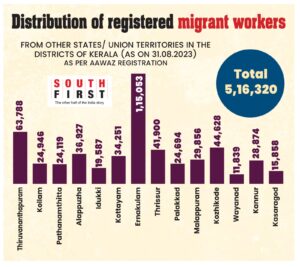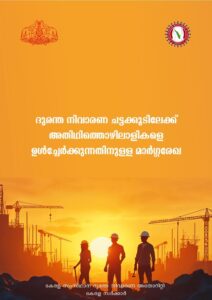Despite being an integral part of Kerala’s workforce, guest workers often lack access to early warnings due to language barriers, habitats in disaster-prone areas with poor infrastructure, and struggle with identity loss and mobility restrictions in the aftermath of calamities.
Published Mar 28, 2025 | 8:00 AM ⚊ Updated Mar 28, 2025 | 8:00 AM

Construction workers. (iStock)
Synopsis: Migrant workers are being actively integrated into disaster preparedness and response strategies, ensuring they are not just contributors to Kerala’s growth but also protected members of its society in times of crisis. The move follows a new guideline by the KSDMA that highlighted the glaring vulnerabilities of migrant workers during disasters, exposing systemic gaps that leave them among the most affected yet least protected.
Kerala, known for its superior living standards and attractive employment opportunities, has long been a magnet for migrant workers from across India.
Officially recognised as “guest workers” by the state, these labourers are a crucial pillar of Kerala’s economy. Despite their contributions, they remain among the most vulnerable during disasters — trapped by social, economic, and logistical barriers.
Recognising this critical gap, the Kerala State Disaster Management Authority (KSDMA) is taking a significant step forward.
For the first time, migrant workers are being actively integrated into disaster preparedness and response strategies, ensuring they are not just contributors to Kerala’s growth but also protected members of its society in times of crisis.
Though guest workers are the backbone of Kerala’s economy, their actual numbers remain a mystery. While the Aawaz programme (an insurance programme for guest workers implemented by the Department of Labour and Skills) has recorded around 5.16 lakh workers, the Athidhi Portal (registration portal by the Labour Commissionerate) lists 3.72 lakh.

Data of guest workers from Labour Commissionerate
In stark contrast, a 2021 State Planning Board study estimated a staggering 31 lakh migrant workers in the state.
According to the Economic Review 2024, migration patterns have shifted — workers now stay for short periods before returning home, making precise data collection difficult.
Earlier, migrants arrived mostly from Tamil Nadu, Karnataka, and Maharashtra. Currently, the majority come from West Bengal, Assam, Odisha, and Bihar.
They dominate key sectors, with 17.5 lakh in construction and 6.3 lakh in manufacturing, while also working in agriculture and hospitality.
Despite Kerala’s welfare initiatives, the lack of accurate data hinders effective policy-making.
A new guideline by the KSDMA highlighted the glaring vulnerabilities of migrant workers during disasters, exposing systemic gaps that leave them among the most affected yet least protected.

The guideline of KSDMA that calls for inclusion of migrant workers in disaster preparedness
Despite being an integral part of Kerala’s workforce, guest workers often lack access to early warnings due to language barriers, habitats in disaster-prone areas with poor infrastructure, and struggle with identity loss and mobility restrictions in the aftermath of calamities.
The absence of formal employment contracts and insurance further compounds their risks, leaving them financially stranded when their livelihoods are disrupted.
The guideline stresses that exclusion from official disaster relief mechanisms due to limited government registration keeps migrants on the margins of aid distribution.
Their lack of representation in local disaster management committees means their specific needs remain overlooked in planning and response efforts.
The Sendai Framework for Disaster Risk Reduction (2015-2030) underscores the urgency of inclusive strategies, urging local authorities to strengthen disaster governance by integrating migrant communities into preparedness plans.
Unless systemic barriers are addressed, migrant workers will continue to be the overlooked victims of Kerala’s disasters, suffering in silence while rebuilding the state’s economy.
The guideline noted, “In Kerala, where guest workers form a crucial part of the economy, the state’s disaster management principle underscores the need for their systematic inclusion in disaster preparedness and response strategies.”
It also reminded that past crises, including the 2018 floods, the Covid-19 pandemic, and the Chooralmala-Mundakkai landslide disaster in Wayanad, have highlighted the vulnerabilities of migrant workers during emergencies.
Aligning with the Sendai Framework’s call for resilience-building, Kerala aims to strengthen early warning systems and emergency services to ensure equitable recovery and social protection for all, including migrant communities.
Officials stress that integrating migrant workers into state, district, and local disaster management plans is both a humanitarian and economic necessity.
“Migrant workers are an integral part of Kerala’s workforce, and their protection during disasters is essential for the state’s economic stability and social equity,” said an official from the KSDMA.
The official further added, “Ensuring their safety aligns with India’s commitment to the 2015-2030 Framework for Disaster Risk Reduction and upholds the right to livelihood under Article 21 of the Constitution. By prioritising inclusive disaster risk reduction, Kerala seeks to build a more resilient and sustainable recovery framework that leaves no one behind.”
The KSDMA stated that recognising the vulnerabilities of migrant workers during calamities, the state is working on a comprehensive strategy to ensure their safety and resilience.
A key initiative involves establishing multilingual early warning systems to effectively reach guest workers, who often face language barriers.
Specific vulnerability assessments will also be conducted, considering their living conditions and limitations in accessing local resources.
Authorities plan to include migrant workers in participatory risk assessments, ensuring their voices are heard in disaster planning.
Additionally, the state will integrate guest worker-specific data into its disaster management system to enhance early response efforts.
To strengthen community-based disaster management, Kerala will deploy linkage workers from within the migrant community.
These workers, fluent in multiple languages, will serve as critical intermediaries between authorities and migrant labourers, facilitating communication and emergency response.
With these measures, Kerala aims to create a more inclusive and efficient disaster management framework, ensuring the safety and well-being of its large guest worker population in the face of recurring natural calamities.
The guideline underscored that accurate data collection on guest workers in Kerala is crucial for effective disaster response, ensuring their safety during crises.
“Local self-government institutions should lead efforts to maintain a secure registry of guest workers, capturing essential details such as numbers, occupations, locations, and vulnerabilities while upholding privacy standards,” it stated.
Leveraging social networks, employers, and recruitment agencies can facilitate ethical data gathering, ensuring compliance with Kerala’s data protection norms.
Encouraging guest workers to voluntarily share information will enhance their access to emergency assistance.
Additionally, empowering guest workers with disaster preparedness programmes, financial inclusion initiatives, and identification documentation will strengthen their resilience.
The guideline also stated that local authorities must address systemic issues like language barriers and inadequate working conditions to improve their response capacity.
Promoting awareness about climate risks, emergency services, and financial literacy, alongside positive image-building campaigns, can foster inclusivity and combat xenophobia.
By proactively integrating migrant workers into disaster preparedness and response, Kerala is taking a crucial step toward inclusive resilience.
With multilingual early warning systems, participatory risk assessments, and community-based interventions, the state aims to bridge systemic gaps and uphold the dignity of its guest workers, thus trying to set a model for disaster governance that truly leaves no one behind.
(Edited by Muhammed Fazil.)
